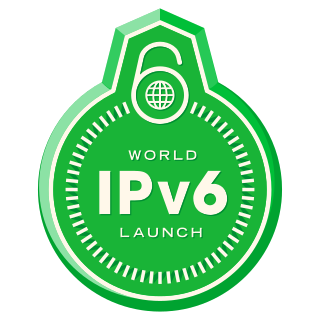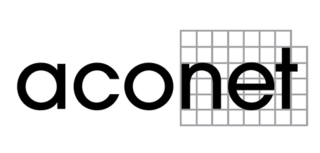An Internet Protocol address is a numerical label such as 192.0.2.1 that is assigned to a device connected to a computer network that uses the Internet Protocol for communication. IP addresses serve two main functions: network interface identification, and location addressing.

Internet Protocol version 6 (IPv6) is the most recent version of the Internet Protocol (IP), the communications protocol that provides an identification and location system for computers on networks and routes traffic across the Internet. IPv6 was developed by the Internet Engineering Task Force (IETF) to deal with the long-anticipated problem of IPv4 address exhaustion, and was intended to replace IPv4. In December 1998, IPv6 became a Draft Standard for the IETF, which subsequently ratified it as an Internet Standard on 14 July 2017.
The Internet Protocol (IP) is the network layer communications protocol in the Internet protocol suite for relaying datagrams across network boundaries. Its routing function enables internetworking, and essentially establishes the Internet.

Border Gateway Protocol (BGP) is a standardized exterior gateway protocol designed to exchange routing and reachability information among autonomous systems (AS) on the Internet. BGP is classified as a path-vector routing protocol, and it makes routing decisions based on paths, network policies, or rule-sets configured by a network administrator.
In computing, Internet Protocol Security (IPsec) is a secure network protocol suite that authenticates and encrypts packets of data to provide secure encrypted communication between two computers over an Internet Protocol network. It is used in virtual private networks (VPNs).

A subnetwork, or subnet, is a logical subdivision of an IP network. The practice of dividing a network into two or more networks is called subnetting.
Internet Neutral Exchange (INEX) is an Internet exchange located in the Republic of Ireland, operating three VLANs at points of presence in Dublin at Equinix DB1 - Citywest, BT - Citywest, Equinix DB2 - Kilcarbery Park, Interxion DUB1 and DUB2 - Park West and Equinix DB3 - Northwest Business Park, Ballycoolin and a separate exchange, INEX Cork, at CIX in Cork.
In computer networking, Teredo is a transition technology that gives full IPv6 connectivity for IPv6-capable hosts that are on the IPv4 Internet but have no native connection to an IPv6 network. Unlike similar protocols such as 6to4, it can perform its function even from behind network address translation (NAT) devices such as home routers.

The Toronto Internet Exchange Community (TorIX) is a not-for-profit Internet Exchange Point (IXP) located in a carrier hotel at 151 Front Street West, Equinix's TR2 data centre at 45 Parliament Street and 905 King Street West in Toronto, Ontario, Canada. As of March 2021, TorIX has 259 unique autonomous systems representing 285 peer connections and peak traffic rates of 1.344 Tbps, making it the largest IXP in Canada. According to Wikipedia's List of Internet Exchange Points by Size, TorIX is the 16th largest IXP in the world in numbers of peers, and 17th in the world in traffic averages. The Exchange is organized and run by industry professionals in voluntary capacity.

The Atlanta Internet Exchange (AtlantaIX) is an Internet Exchange Point situated in Atlanta, Georgia, United States. AtlantaIX is a fast-growing, neutral and independent peering point. The beginnings of the AtlantaIX can be traced back to 1997. The current version of the AtlantaIX was re-established on September 4, 2003 by Michael Lucking, GreatAccess.com, WV Fiber and 56 Marietta Street Partners. AtlantaIX was originally created as a free exchange point sponsored by the donations of the founders. Today AtlantaIX continues to run without any re-occurring charges to the participants. In 2007, one time port fees were instituted to aid in paying for a recently upgraded switch infrastructure. In January 2007, Michael Lucking purchased a new Foundry Networks Jetcore 15000 in order to support 10 Gigabit Ethernet connections. In January 2008 the switch fabric was migrated to a Cisco 6509 in order to support line rate 10 gigabit Ethernet. In early 2008, the AtlantaIX began supporting IPv6.
An IPv6 transition mechanism is a technology that facilitates the transitioning of the Internet from the Internet Protocol version 4 (IPv4) infrastructure in use since 1983 to the successor addressing and routing system of Internet Protocol Version 6 (IPv6). As IPv4 and IPv6 networks are not directly interoperable, transition technologies are designed to permit hosts on either network type to communicate with any other host.
The deployment of IPv6, the latest version of the Internet Protocol (IP), has been in progress since the mid-2000s. IPv6 was designed as the successor protocol for IPv4 with an expanded addressing space. IPv4, which has been in use since 1982, is in the final stages of exhausting its unallocated address space, but still carries most Internet traffic.
The Belgian National Internet eXchange (BNIX) is an internet exchange point operated by the Belgian national research network BELNET. Created in 1995, it is one of the charter members of Euro-IX, the European Internet Exchange Association.
Hurricane Electric is a global Internet service provider offering Internet transit, tools, and network applications, as well as data center colocation and hosting services at two locations in Fremont, California, where the company is based.

An Internet Protocol version 6 address is a numeric label that is used to identify and locate a network interface of a computer or a network node participating in a computer network using IPv6. IP addresses are included in the packet header to indicate the source and the destination of each packet. The IP address of the destination is used to make decisions about routing IP packets to other networks.

World IPv6 Day was a technical testing and publicity event in 2011 sponsored and organized by the Internet Society and several large Internet content services to test and promote public IPv6 deployment. Following the success of the 2011 test day, the Internet Society carried out a World IPv6 Launch day on June 6, 2012 which, instead of just a test day, was planned to permanently enable IPv6 for the products and services of the participants.
The YYCIX Internet Exchange Community Ltd (YYCIX) in Calgary, Canada is the first Internet exchange point (IXP) in Alberta. It allows the local exchange of Internet traffic between members, staying within Canadian jurisdiction, optimizing the performance and economy of traffic flows, and limiting the potential for extra-legal surveillance. The YYCIX follows IXP best-practices, in that it is neutral and independent, has no mandatory fees, and is supported entirely through voluntary donations. The YYCIX is incorporated as a Canadian tax-exempt non-profit corporation.

ACOnet is the name of the national research and education network in Austria. The ACONET association promotes the development and use of that network. ACOnet is not managed and operated by ACONET, but by a unit in the Computing Centre of the University of Vienna that also operates the Vienna Internet Exchange. The University of Vienna represents ACOnet internationally, for example as a member of TERENA and as a participant in the project that funds the European backbone network GÉANT.
UAE-IX is a carrier- and data center-neutral internet exchange point (IXP) situated in Dubai (UAE). It interconnects global networks, network operators and content providers in the GCC region. Founded in 2012, UAE-IX is built on a fully redundant switching platform located in two data centers in Dubai, Datamena and Equinix. Initiated by the UAE’s Telecommunication Regulatory Authority (TRA) and fully managed by DE-CIX, UAE-IX delivers a local alternative for regional traffic exchange, localizing Internet content.









